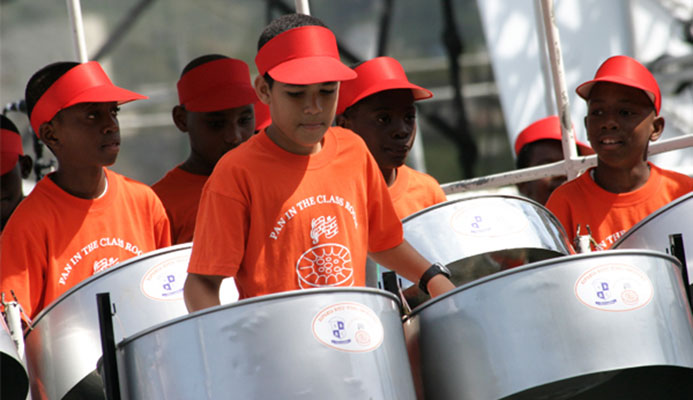The steel pan is the national instrument of Trinidad and Tobago. It is the only musical instrument invented in the twentieth century.
Created in the 1930’s, the steel pan owes its genesis to the carnival festivals of that era. It emerged as the product of the energy of the people directed towards cultural self-expression. The steelpan therefore became a cultural vehicle forged from the historical and social conditions prevailing at that time. Its development was moulded by the ethnic influences of our heritage.
HISTORICAL DEVELOPMENT
Carnival celebrations in the late 1800’s were marked by disturbances which prompted the authorities to prohibit the unlicensed playing of all percussion, string and wood-wind instruments by way of legal ordinance. This led to the development of the Tamboo-Bamboo as a musical instrument. The Tamboo-Bamboo was made from bamboo cut to various lengths and its sound was produced by stamping onto the ground. Carnival celebrations in the five decades from 1884 to the late 1930s witnessed the growing rhythms of Tamboo-Bamboo musical ensembles in street processions with accompanying brass and string instrumental bands.
Several problems with the bamboo material, including its tendency to splinter easily, resulted in experimentation with other materials such as metal containers, to produce various sound effects. These experiments resulted in the discovery of the steel drum since it proved to be more durable than other material and capable of greater tonal versatility.
This drum, originally used to store petroleum, evolved into the steel pan by making cross-sections cut into the 55-gallon metal container. Through further experimentation, percussive sounds of various pitches were produced by indenting and tempering the concave metal surface. The steel drum therefore was used in the creation of what is known today as the steel pan, and although there have been several competing claims to its invention, it is generally accepted that the steel pan was first made around 1939 in Trinidad and Tobago.
Carnival of 1940 witnessed the first public appearance of the steel pan and it has since evolved through the ingenious innovations of various contributors. These innovations have resulted in instruments of different tonal ranges which now comprise the musical ensemble of the modern steelband.
The steelpan has risen from the deprived urban tenements of Port-of-Spain where it was forged, to acceptance and promotion by the international community. What has brought this instrument forward onto the world stage was the devotion, talent and industry of its early followers. This is a significant achievement in the face of the financial obstacles and disdain by society for the thuggery and violence once associated with it.

